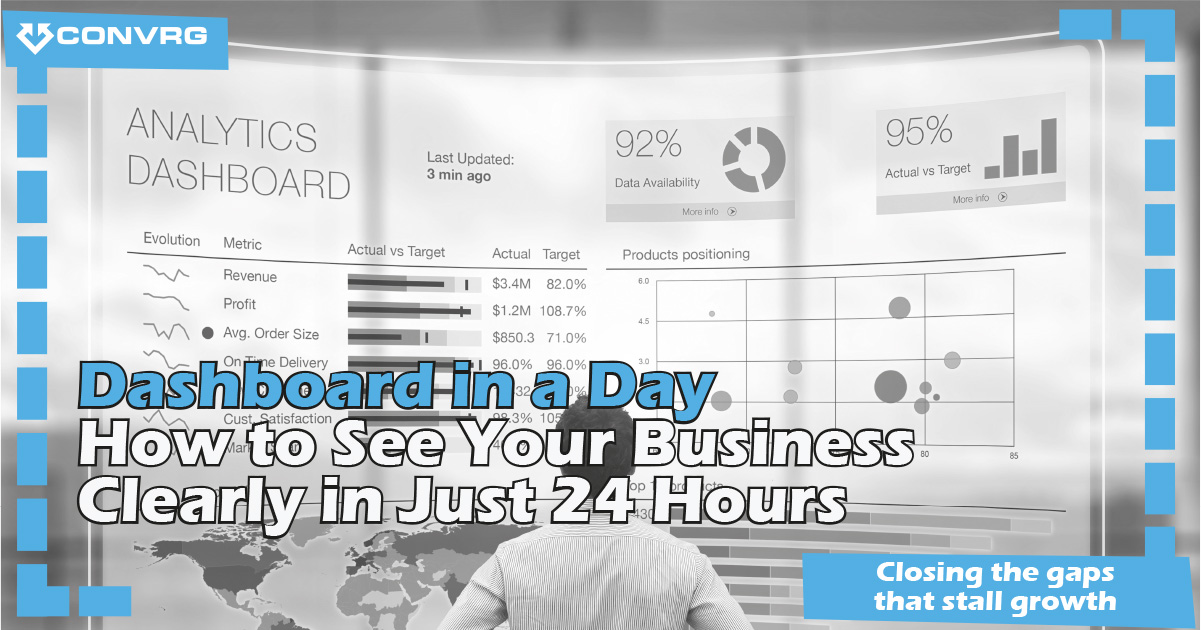The Boardroom Breakdown
It’s Thursday morning.
The boardroom’s quiet but tense - the kind of meeting where everyone knows the numbers are about to get tested.
Your HubSpot dashboard glows confidently on the big screen.
Charts are sharp. Pipeline looks strong. Forecasts are optimistic.
You’ve rehearsed this moment.
“Pipeline’s healthy,” you begin.
“Revenue’s tracking ahead. Marketing’s smashed MQL targets. We’re on plan.”
The CEO nods slowly. The CFO leans forward, scanning the numbers.
And then the Chair asks the one question that always lands like a grenade:
“If the forecast is this good, why did we miss target last quarter?”
Silence.
The CFO speaks first:
“Our finance numbers don’t match these forecasts.”
Sales jumps in:
“Half those deals are still stuck.”
Marketing pushes back:
“Our leads are qualified — sales isn’t converting.”
Within five minutes, your perfectly polished dashboard has become a weapon.
Not against competitors - against you.
Sound familiar? You’re not alone.
At CONVRG, we’ve audited hundreds of HubSpot dashboards. In 7 out of 10 cases, leadership teams were making million-pound decisions on dashboards they couldn’t trust.
It’s not a HubSpot problem.
It’s a leadership visibility problem.
And that’s exactly what Dashboard in a Day was built to fix.
The Illusion of Clarity
Dashboards make leaders feel safe.
That’s the trap.
When the charts are colourful, the pipeline bars are trending up, and the forecast line looks smooth, it feels like you’re in control.
But dashboards lie - and they lie quietly.
Why Leaders Trust Dashboards Too Much
Dashboards are performative by design.
They’re built to make the business look like it’s performing well.
We’ve seen dashboards designed to:
- Celebrate marketing’s lead volume - without showing quality.
- Show pipeline growth - but include unqualified, stalled deals.
- Present forecasts based on lifecycle stages nobody updates.
They look clean. They look credible.
But they’re often built from the bottom up, not the top down.
Four Reasons Dashboards Break
Dashboards don’t fail in one big moment.
They erode gradually, until leaders don’t realise how unreliable they’ve become.
Here’s where it happens.
- Data Debt
Every business collects “data debt” over time:
- Duplicate contacts inflate lead counts.
- Missing fields break key filters.
- Disconnected integrations push unstructured data into HubSpot.
If the data’s wrong, the dashboards are wrong.
And if the dashboards are wrong, every decision based on them is compromised.
- No Shared Definitions
Ask your CRO, CMO, and COO to define a “qualified lead.”
If you get three answers, your dashboards are already broken.
Without shared definitions:
- Marketing thinks its job is done at MQL.
- Sales complains about lead quality.
- Finance stops trusting pipeline forecasts.
The board gets three different answers from three senior leaders.Confidence evaporates.
- Bottom-Up Chaos
Dashboards often evolve organically:
- Marketing builds dashboards to prove ROI.
- Sales builds dashboards to hit quota.
- Ops builds dashboards to monitor processes.
Each team optimises for itself.
Nobody designs dashboards for leadership clarity.
Exec dashboards get stitched together from fragments.
It looks comprehensive - until you realise nobody’s seeing the same truth.
- Vanity Metrics
Pretty numbers hide real problems:
- Page views.
- Email opens.
- Form fills.
- Webinar attendees.
Vanity metrics make dashboards look good in the boardroom - but they don’t help leadership make decisions.
It’s data theatre, not leadership visibility.
The Cost of Broken Dashboards
When dashboards drift, the cost to leadership is huge - and mostly invisible until it’s too late.
Slower Decisions
When dashboards disagree, leadership wastes time debating numbers instead of acting on them.
Opportunities slip. Competitors move faster.
Strategic Misfires
Bad dashboards drive bad bets:
- Overinvesting in “high-performing” channels that don’t actually convert.
- Overhiring based on inflated forecasts.
- Missing churn signals until customers are gone.
Boardroom Distrust
Boards expect precision.
When dashboards contradict finance reports:
- Confidence in leadership evaporates.
- Investors get nervous.
- Funding rounds stall.
This isn’t just embarrassing - it’s existential.
The Adoption Death Spiral
Once leadership stops trusting dashboards:
- Sales reps stop updating deals.
- Marketing stops enriching contacts.
- Ops loses visibility into performance.
Within months, your “single source of truth” turns into a single point of failure.
Case Study: Frontier Medical
When Frontier Medical came to us, they thought dashboards were the one thing they’d got right.
Marketing reported record-breaking MQLs.
Sales showed a booming pipeline.
Leadership presented the dashboards to the board with confidence.
But forecasts kept missing by double digits.
An audit uncovered:
- 40% of MQLs were duplicates.
- Pipeline value inflated by £1.2m.
- Lifecycle stages were inconsistent across teams.
- Forecast accuracy off by 50%+.
We rebuilt their dashboards from the top down:
- Defined KPIs leadership actually cared about.
- Standardised lifecycle stages across teams.
- Delivered a single exec-ready reporting layer tied to board-level metrics.
Within six weeks:
- Forecast accuracy improved by 94%.
- Board debates shifted from “whose numbers are right” to “what’s next.”
- Leadership trust was restored.
The 24-Hour Reset
Here’s the truth:
You don’t need a six-month rebuild to fix your dashboards.
You need a leadership-led reset.
That’s why we built Dashboard in a Day.
How It Works
In just 24 hours, we:
- Audit - Review your dashboards, data integrity, KPIs, and reporting definitions.
- Align - Facilitate leadership alignment on success metrics and lifecycle stages.
- Rebuild - Deliver a clean, exec-ready dashboard designed around decisions, not decoration.
What You Get
- One dashboard your entire leadership team can trust.
- One version of the truth across sales, marketing, and finance.
- One set of KPIs tied to strategy, not vanity metrics.
- One reporting layer the board actually believes.
All in 24 hours.
Case Study: Bridgend College
Bridgend College adopted HubSpot, but reporting drifted fast after headcount reductions:
- Marketing tracked lead volumes.
- Admissions tracked conversions separately.
- Leadership couldn’t get a unified picture.
Within a single Dashboard in a Day, we:
- Realigned lifecycle definitions.
- Simplified reporting into leadership-ready dashboards.
- Delivered clarity overnight.
Next board meeting?
Total confidence.
Adoption recovered.
Leadership moved faster.
The Dashboard Stress Test
Before your next leadership meeting, ask yourself:
- Can you defend every number on your dashboards under questioning?
- Do finance, sales, and marketing all agree on these KPIs?
- Does your forecast stand up to investor scrutiny?
- Could you run the business for 90 days based on this dashboard alone?
If the answer’s “no” to two or more, you need a reset.
Book Dashboard in a Day
In just 24 hours, you’ll walk away with:
- One dashboard.
- One source of truth.
- One version of the numbers everyone trusts.
[Book Dashboard in a Day]
See your business clearly - tomorrow.







